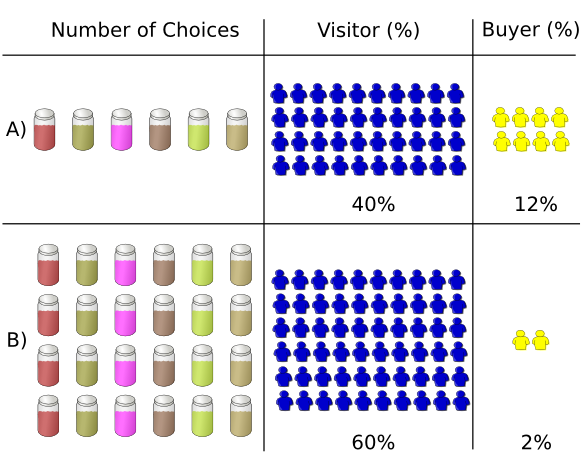A few month ago I viewed a TED talk by Barry Schwartz the author of The paradox of choice – Why less is more. He began with a little story that I wanted to retell:
When I was young there were 3 types of jeans, they did not have a great quality but it was easy to decide. In our days if you go into a store there are 1.000 types of jeans. He tried 25 of them and then he bought one. It was the best fitting jeans he have ever worn but He was unhappy with his choice.
 For customers it is especially difficult to choose from huge product sets in the internet. They do not know what fits their tastes and with a growing possibility of choices they are more likely to not choose at all. To help the customers in their decision making process it is necessary to analyze their behavior and recommend fitting products for them.
For customers it is especially difficult to choose from huge product sets in the internet. They do not know what fits their tastes and with a growing possibility of choices they are more likely to not choose at all. To help the customers in their decision making process it is necessary to analyze their behavior and recommend fitting products for them.Choice overload

The famous example that is often quoted in the literature is an experiment which was conducted in 2000. It was called When Choice is Demotivating: Can One Desire Too Much of a Good Thing? by Sheena S. Iyenger and Mark R. Lepper. The two researchers sold jam in a super market. At the first weekend they had 6 different jams and around 12% of the attracted people bought. At the next weekend they had 24 different jams and only 2% of the attracted people bought.
Cognitive biases
We have a lot of cognitive biases which sometimes help in live but sometimes don’t. For a marketer it is important that the used software helps him in exploiting these cognitive biases of their customers and try to make them happy by offering good and fitting products. Every marketer must test the different biases for their audience individually. This can be done with hypothesis and research like user interaction studies.
Moral judgment
We do not know what we like until we feel it. Our brain is a complicated system. In the paper The Emotional Dog and its Rational Tail: A Social Intuitionist Approach to Moral Judgment by Jonathan Haidt he states that we first have a feeling about something and later we try to convince ourselves why we like or hate a certain thing.
You have to make your products feelable for your customers and tell them a story that involves them.
Leave a Reply